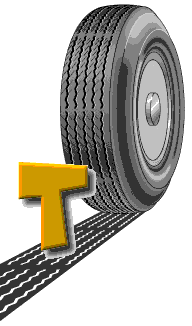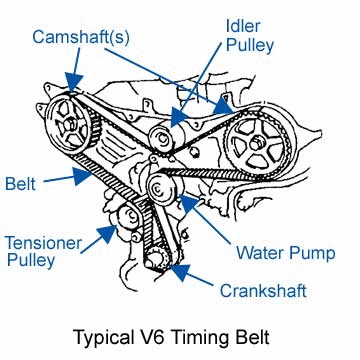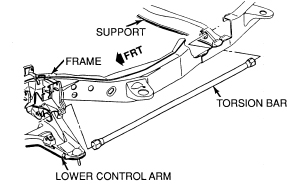|

Ta
Th
Ti
To
Tr
Tu
Tw
Tachometer
An instrument that indicates the number of revolutions per
minute at which the engine is turning.
Tailpipe
The rearmost part of the exhaust
system, through
which exhaust gases are vented into the atmosphere. Many specialty
product manufacturers offer attractive tailpipe designs in various
diameters and in various finishes, including chromed steel and
polished stainless steel. Changing the tailpipe can enhance a
vehicle's styling, and it also can affect the loudness of the exhaust.
Tappet
A cylindrical component which transmits motion from the cam to the
valve stem, either directly or via a pushrod and rocker arm. Also
called a cam follower.
Thermostat
The thermostat is an important part of the engine's cooling system.
|
It
closes the coolant flow to the radiator when the engine is cold, and
opens it when the engine reaches normal operating temperature. This
is a small and inexpensive part, but its failure may cause engine
overheating, which in turn may result in serious engine damage. As
soon as you note the engine temperature starts rising more than
normal level, have your vehicle inspected, possible it needs new thermostat. |
 |
Throttle
The device that controls the vacuum created in the venturi of the
carburetor. The greater the vacuum, the richer the fuel-air mixture.
The throttle enables the engine to run on a richer mixture and
produce more power for high-speed driving. It consists of a throttle
arm located on the outside of the carburetor and connected to the gas
pedal (or throttle twist grip on a motorcycle), which in turn
activates a throttle butterfly valve at the base of the carburetor
barrel where it joins the intake manifold.
Throttle Arm
The lever that actuates the throttle.
Throttle-Body
Throttle-Body Fuel Injection is a type of Electronic Fuel
Injection which positions the injector(s) centrally in a
throttle-body housing. This housing contains a valve to regulate the
airflow through the intake manifold.
Throttle Butterfly
A valve in the throat of the carburetor which regulates the amount
of the flow of gasoline. See throttle valve.
Throttle Pedal
The gas
pedal which
operates the throttle
butterfly
through a series of linkages.
Throttle Plate
A term used for throttle
valve.
Throttle Valve
[1]
A valve in the carburetor. It is used to control the amount of
air-fuel mixture that reaches the cylinders. Usually consists of a
flat round disc mounted on a shaft so that it can be tilted at
various angles in the carburetor throttle valve body. It is connected
by suitable linkage to the accelerator pedal.
[2]
A modulator valve in an automatic transmission which is actuated
either by the accelerator pedal, by the vacuum in the engine intake
manifold, or by the carburetor throttle; it converts line pressure
into an engine-load dependent pressure, which is directed to various valves
Thrust
Bearing The bearing in the clutch assembly that is moved
in to the release levers by clutch pedal action to disengage the
clutch. Also referred to as a release bearing.
Tie
Rod Ends Tie rod ends are utilized in the steering linkage,
steering knuckle pivot supports, and various other hinge mechanisms.
Ball joints that join the key parts of the steering linkage pass on
the steering wheel's motion no matter what the angle of the linkage
or the vibration from the road.
|
Timing
Belt A toothed belt which drives the camshaft.
Serious engine damage may result if it breaks in service.
The
automobile engine uses a metal timing chain, or a flexible toothed
timing belt to rotate the camshaft. The timing chain/belt is driven
by the crankshaft. |
 |
The
timing chain, or timing belt is used to "time" the opening
and closing of the valves. The camshaft rotates once for every two
rotations of the crankshaft.
Discover
How The Timming
Belt
Works in The
Engine
Timing
chain A chain which drives the camshaft. See Timing
Belt above
Tires
A tire is a tubular corded carcass covered with rubber or
synthetic rubber, which is mounted on a wheel and inflated to provide
traction for moving a vehicle and for assisting the brakes in
stopping it.
Tire
Ratings Tires are rated by load capacity, size and speed
capacity. For example, a P225/50VR16 printed on the side of the tire means:
|
P
= P-Metric (Passenger Type Tire)
255
= Section Width (255mm)
50
= Aspect Ratio (tire height/section width)
V
= Speed Rating
R
= Type of Ply (Radial)
16
= Wheel Diameter (16 inches) |
|
Tire
and wheel dimensions are the first point of information in any
discussion of size and capacities. Among the other terms used to
describe tires are: tread, shoulder, carcass, sidewall, bead seal,
bead seat, tire diameter, aspect ratio, speed rating and section width
Toe-in
The amount the front wheels are closer together at the front than at
the rear. On rear wheel drive vehicles, a slight amount of toe-in is
usually specified to keep the front wheels running parallel on the
road by offsetting other forces that tend to spread the wheels apart.
Toe-out
The amount the front wheels are closer together at the rear than at
the front. On front wheel drive vehicles, a slight amount of toe-out
is usually specified.
Top
Dead Center: ( TDC ) Highest point of piston and connecting-rod
travel in a cylinder; the ends of the compression and exhaust strokes
in a four-cycle engine.
Torque
A force that produces a twisting or rotating motion.
[1]
Turning or twisting force such as the force imparted on the drive
line by the engine. Usually measured in lb-ft. It differs from work
or power in that torque does not necessarily produce motion.
Basically, the magnitude of a torque acting on a body is the product
of the magnitude of a force and its force arm (perpendicular distance
from the axis of rotation of the body to the line of action of the
force). This product is called the moment of the torque about the
axis or the torque.
[2]
To tighten a nut or bolt with a torque wrench.
Torque
Converter A unit in an automatic
transmission,
quite similar to the fluid
coupling, that
transfers engine torque
to the transmission input
shaft. It also
cushions the flow of power. Unlike the fluid coupling, the torque
converter can multiply engine torque. This is accomplished by
installing one or more stators
between the torus
members. In the torque converter the driving torus is referred to as
the "pump" and the driven torus as the "turbine."
The engine drives the impeller
which in turn impels fluid against the vanes
of a turbine connected through transmission gears to the driveshaft
of the automobile. The stator redirects oil flow from the turbine to
boost impeller action and multiply engine torque.
torque
converter drive plate: See drive plate
torque
converter housing: A bell housing
torque
converter lock-up clutch: An automatically engaged clutch in a
lock-up torque converter which prevents slipping losses
Torque
Converter Clutch An electronically controlled lockup clutch that
is automatically engaged at certain speeds to eliminate the slip
between the torque converter's input and output, thereby improving
fuel efficiency and performance.
Torque,
Engine Engine torque is the amount of twisting effort exerted at
the crankshaft by an engine expressed in foot-pounds of force. A
foot-pound represents the force of one pound acting at the right
angle to the rotating crankshaft at distance of one foot in length.
Torque
Rating A measure of the engine's power capability, whereby the
amount of twisting or rotating effort being exerted on the crankshaft
is expressed in lb.-ft. of force. Torque is the force that gets the
weight of the vehicle moving, making it an important consideration in trailering.
|
Torsion
Bar A rod in the suspension system that, when twisted from
a grip at one end, functions like a spring.
A
long spring steel rod attached in such a way that one end is
anchored while the other is free to twist. |
 |
One
end is fastened to the frame at one end and to a suspension part at
the other. If an arm is attached, at right angles, to the free end,
any movement of the arm will cause the rod or bar to twist the bar's
resistance to twisting provides a spring action. The torsion bar
replaces both coilleaf springs in some suspension systems. The main
advantage of the torsion bar over the coil spring in the front
suspension is the ease of adjusting front suspension height.
Torsion
Bar Suspension A
suspension system that makes use of torsion bars in place of the
leaf or coil spring.
Torus
The inner surface of a hollow doughnut-shaped structure, especially
found in automatic transmissions. See fluid
coupling.
Tracer
A stripe of a second color applied to a wire insulator to
distinguish that wire from another one with the same color insulator.
Trailing
Arm A rear suspension element consisting of a lengthwise member
that pivots from the body at its forward end and has a wheel hub
rigidly attached to its trailing end.
Transaxle
A transmission and differential combined in one integrated assembly,
eliminating the need for a separate connecting drive shaft. This
configuration is typical in front-wheel-drive vehicles.
Transformer
An electrical device with an arrangement of copper coils with an
iron center, used to increase or decrease electrical voltage. A
vehicle ignition coil transforms the voltage from 12 volts to upward
of 20,000 volts.
Electromagnetic device which transfers electrical energy from
primary circuit into variations of voltage in secondary circuit.
Transmission
The gear-changing or gear-shifting system through which engine power
is transferred to the wheels. The purpose of gear-changing is to keep
maximum engine power applied to the wheels at all times for all
conditions, from start-up to high speeds.
See
also Automatic
Transmission
& Manual
Transmission
Discover
How The Transmission
Works in Your
Vehicle
Transmission
Fluid Dip Stick The transmission fluid dip stick is a long metal
rod that goes into the transmission. It serves check how much
transmission fluid is in the transmission. The dip stick is held in a
tube; the end of the tube extends into the transmission. It has
measurement markings on it. If you pull it out, you can see whether
you have enough transmission fluid, or whether you need more by the
level of fluid on the markings. Most manual transmissions do not have
dipsticks, instead they use a filler hole which is at the same level
as the correct oil level. When the oil is topped up or refilled, the
mechanic simply adds oil until the filler hole's level is reached.
Transmission
Gears Most cars have from three to five forward gears, and
one reverse gear. The transmission changes the ratio of the engine
speed and the wheels by connecting gears in various combinations.
First gear connects the engine power to the drive wheels via a pair
of reduction gear sets, which gives increased power and reduced
wheelspeed when the car is beginning to move. Gears work exactly like
levers. A small gear driving a larger one gives an increase in
torque, and a decrease in speed, and vise-versa. Transmission gears
are heat-treated, high quality steel. They have smooth, hard teeth,
cut on precision machinery while red hot. There are many types of
gear teeth, but most transmissions use spur and helical gears. Most
of the gears are the helical type, because they last longer and are
more quiet than spur gears. There has to be enough room (a few
thousandths of an inch) between the gear teeth for lubrication,
expansion, and any irregularities in size.
Transmission
tunnel The transmission tunnel is a cone-shaped formation in the
front of the floor pan. Its shape duplicates the transmission, but it
is a little bit bigger and provides about two inches of clearance
around the transmission. The transmission tunnel does not exist in
front wheel drive cars, because the transmission is on the side of
the engine completely under the hood. Only rear-wheel drive cars have
transmission tunnels. A manual transmission tunnel has a hole in it
to allow the shift linkage to be worked from inside the car. The
shifter linkage goes through the transmission tunnel. A rubber boot
on the shifter linkage stops dirt, dust and exhaust fumes from
entering the passenger compartment. The rubber boot is mounted onto
the transmission tunnel and fastened securely around the gearshift
linkage. Vehicles with automatic transmission do not need a
transmission tunnel because the shift linkage does not usually go
through the transmission tunnel. The shift linkage in automatic
transmission usually goes in front of the firewall from the base of
the steering column.
Transverse
Engine An engine that is mounted laterally (i.e., left to right)
between the drive wheels (rather than longitudinally - front to
back), often found on cars with front-wheel
drive.
Also
called "east-west layout"
Tread
The
pattern on the surface of a tire
Also
the width of a car measured from the center line of the wheels.
Sometimes called the track.
Tune-up
A process of accurate and careful adjustments and parts replacement
to obtain the best possible engine performance.
Turbine
[1]
The driven member inside a torque converter consisting of many vanes
that receive fluid flow from the impeller.
[2]
A driven member that connects to the transmission input shaft and
provides torque input to the planetary gearset.
A
type of engine in which all the parts that are in regular motion are
rotating, making for very smooth operation. The basic gas turbine
operates as follows: air enters the compressor and is compressed. It
is then delivered to the combustion chamber under pressure and here
the fuel is introduced, mixed with the air and burned, the quantity
injected determining speed and power output. The hot, high-pressure
burning gases then proceed to the first turbine, which drives the
compressor and continue to the power turbine, which delivers power to
the output shaft through reduction gears. The gears are necessary
because the speed of turbine rotation is measured in tens of
thousands of rpm not thousands as with a typical piston engine. The
turbine's attractions include its utter simplicity and directness in
getting power from burning gas, its smoothness, easy cold starting
and its ability to run on almost any hydrocarbon fuel. On the minus
side are high cost, problems with materials because of the high
temperatures and speed of rotation and relatively high NOx
production. Also see gas turbine
Turbine
Engine An engine in which gas pressure is created by
combustion to spin a turbine.
Any
of various machines in which the kinetic energy of a moving fluid is
converted to mechanical power by the impulse or reaction of the fluid
with a series of buckets, paddles, or blades arrayed about the
circumference of a wheel or cylinder.
An
engine that uses burning gases to spin a turbine, or series of
turbines, as a means of propelling the vehicle.
Also
see turbine.
Turbocharger
A centrifugal device, driven by exhaust gases, that pressurizes the
intake air. Normally used to increase the power output from a given
engine displacement, but can also be used primarily to reduce exhaust
emissions (as on VW's "Umwelt" Diesel engine).
Twist
Beam Rear Axle
Twist-Beam
Rear Axle See semi-independent
suspension
Two-Stroke
Cycle An internal-combustion engine that requires only one
revolution per cylinder or two piston strokes (up and down) to
achieve a power stroke. Rarely used in automobiles.

A
B
C
D
E
F
G
H
I J
K
L
M
N
O
P
Q
R
S
T
U
V W
X
Y
Z |